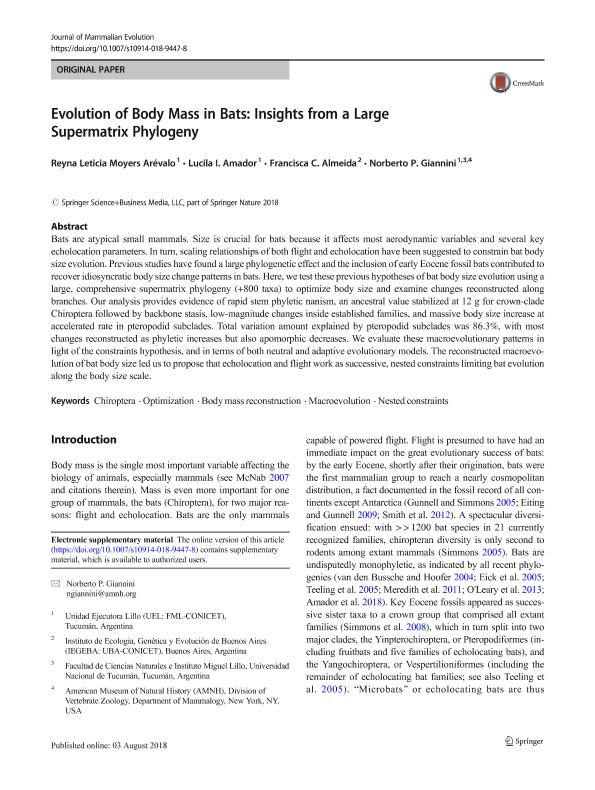Artículo
Evolution of body mass in bats: Insights from a large supermatrix phylogeny
Moyers Arévalo, Reyna Leticia ; Amador, Lucila Inés
; Amador, Lucila Inés ; Cunha Almeida, Francisca
; Cunha Almeida, Francisca ; Giannini, Norberto Pedro
; Giannini, Norberto Pedro
 ; Amador, Lucila Inés
; Amador, Lucila Inés ; Cunha Almeida, Francisca
; Cunha Almeida, Francisca ; Giannini, Norberto Pedro
; Giannini, Norberto Pedro
Fecha de publicación:
08/2018
Editorial:
Springer
Revista:
Journal of Mammalian Evolution
ISSN:
1064-7554
Idioma:
Inglés
Tipo de recurso:
Artículo publicado
Resumen
Bats are atypical small mammals. Size is crucial for bats because it affects most aerodynamic variables and several key echolocation parameters. In turn, scaling relationships of both flight and echolocation have been suggested to constrain bat body size evolution. Previous studies have found a large phylogenetic effect and the inclusion of early Eocene fossil bats contributed to recover idiosyncratic body size change patterns in bats. Here, we test these previous hypotheses of bat body size evolution using a large, comprehensive supermatrix phylogeny (+800 taxa) to optimize body size and examine changes reconstructed along branches. Our analysis provides evidence of rapid stem phyletic nanism, an ancestral value stabilized at 12 g for crown-clade Chiroptera followed by backbone stasis, low-magnitude changes inside established families, and massive body size increase at accelerated rate in pteropodid subclades. Total variation amount explained by pteropodid subclades was 86.3%, with most changes reconstructed as phyletic increases but also apomorphic decreases. We evaluate these macroevolutionary patterns in light of the constraints hypothesis, and in terms of both neutral and adaptive evolutionary models. The reconstructed macroevolution of bat body size led us to propose that echolocation and flight work as successive, nested constraints limiting bat evolution along the body size scale.
Archivos asociados
Licencia
Identificadores
Colecciones
Articulos(IEGEBA)
Articulos de INSTITUTO DE ECOLOGIA, GENETICA Y EVOLUCION DE BS. AS
Articulos de INSTITUTO DE ECOLOGIA, GENETICA Y EVOLUCION DE BS. AS
Articulos(UEL)
Articulos de UNIDAD EJECUTORA LILLO
Articulos de UNIDAD EJECUTORA LILLO
Citación
Moyers Arévalo, Reyna Leticia; Amador, Lucila Inés; Cunha Almeida, Francisca; Giannini, Norberto Pedro; Evolution of body mass in bats: Insights from a large supermatrix phylogeny; Springer; Journal of Mammalian Evolution; 8-2018; 1-16
Compartir
Altmétricas



